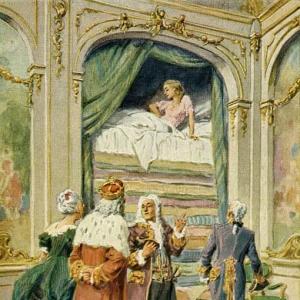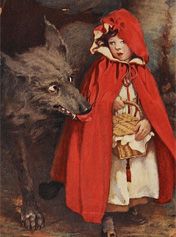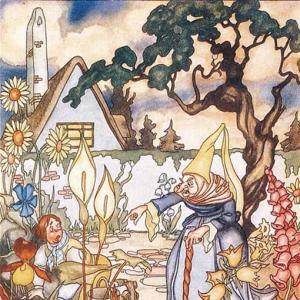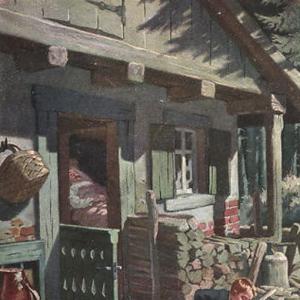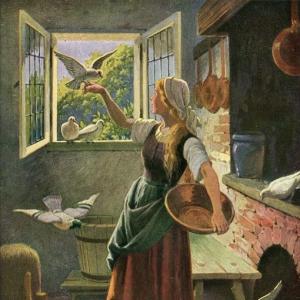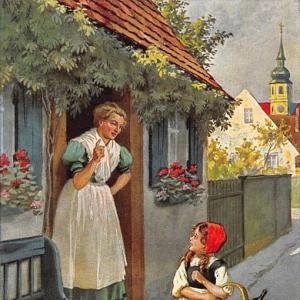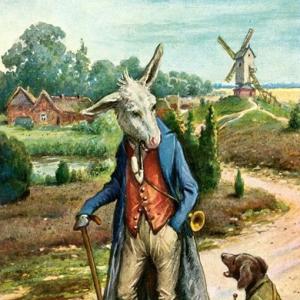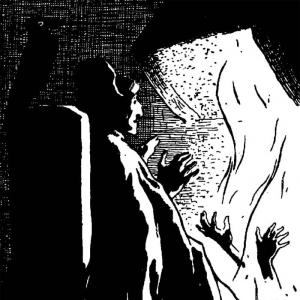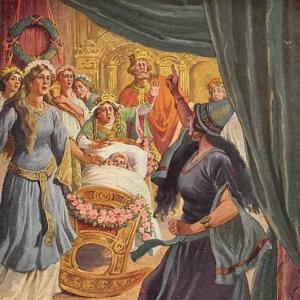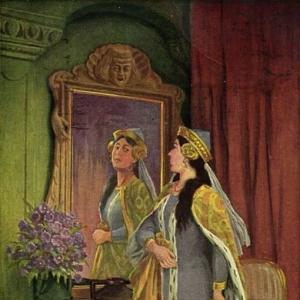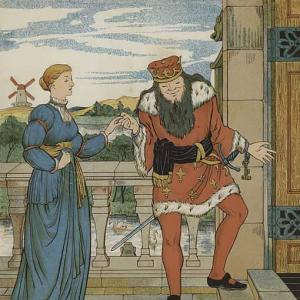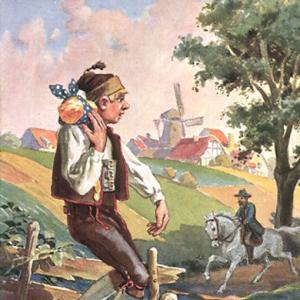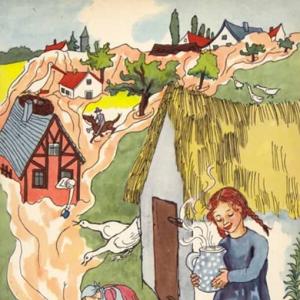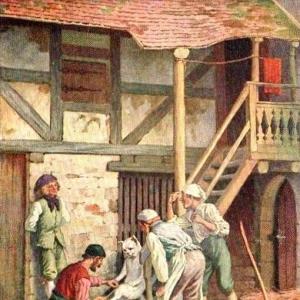Reading time for children: 22 min
There was once on a time an old king who was ill, and thought to himself, „I am lying on what must be my death-bed.“ Then said he, “ Tell Faithful John to come to me.“ Faithful John was his favourite servant, and was so called, because he had for his whole life long been so true to him. When therefore he came beside the bed, the King said to him, „Most faithful John, I feel my end approaching, and have no anxiety except about my son. He is still of tender age, and cannot always know how to guide himself. If thou dost not promise me to teach him everything that he ought to know, and to be his foster-father, I cannot close my eyes in peace.“ Then answered Faithful John, „I will not forsake him, and will serve him with fidelity, even if it should cost me my life.“ On this, the old King said, „Now I die in comfort and peace.“ Then he added, „After my death, thou shalt show him the whole castle: all the chambers, halls, and vaults, and all the treasures which lie therein, but the last chamber in the long gallery, in which is the picture of the princess of the Golden Dwelling, shalt thou not show. If he sees that picture, he will fall violently in love with her, and will drop down in a swoon, and go through great danger for her sake, therefore thou must preserve him from that.“ And when Faithful John had once more given his promise to the old King about this, the King said no more, but laid his head on his pillow, and died.
When the old King had been carried to his grave, Faithful John told the young King all that he had promised his father on his deathbed, and said, „This will I assuredly perform, and will be faithful to thee as I have been faithful to him, even if it should cost me my life.“ When the mourning was over, Faithful John said to him, „It is now time that thou shouldst see thine inheritance. I will show thee thy father’s palace.“ Then he took him about everywhere, up and down, and let him see all the riches, and the magnificent apartments, only there was one room which he did not open, that in which hung the dangerous picture. The picture was, however, so placed that when the door was opened you looked straight on it, and it was so admirably painted that it seemed to breathe and live, and there was nothing more charming or more beautiful in the whole world. The young King, however, plainly remarked that Faithful John always walked past this one door, and said, „Why dost thou never open this one for me?“ – „There is something within it,“ he replied, „which would terrify thee.“ But the King answered, „I have seen all the palace, and I will know what is in this room also,“ and he went and tried to break open the door by force. Then Faithful John held him back and said, „I promised thy father before his death that thou shouldst not see that which is in this chamber, it might bring the greatest misfortune on thee and on me.“ – „Ah, no,“ replied the young King, „if I do not go in, it will be my certain destruction. I should have no rest day or night until I had seen it with my own eyes. I shall not leave the place now until thou hast unlocked the door.“
Then Faithful John saw that there was no help for it now, and with a heavy heart and many sighs, sought out the key from the great bunch. When he had opened the door, he went in first, and thought by standing before him he could hide the portrait so that the King should not see it in front of him, but what availed that? The King stood on tip-toe and saw it over his shoulder. And when he saw the portrait of the maiden, which was so magnificent and shone with gold and precious stones, he fell fainting to the ground. Faithful John took him up, carried him to his bed, and sorrowfully thought, „The misfortune has befallen us, Lord God, what will be the end of it?“ Then he strengthened him with wine, until he came to himself again. The first words the King said were, „Ah, the beautiful portrait! whose it it?“ – „That is the princess of the Golden Dwelling,“ answered Faithful John. Then the King continued, „My love for her is so great, that if all the leaves on all the trees were tongues, they could not declare it. I will give my life to win her. Thou art my most Faithful John, thou must help me.“
The faithful servant considered within himself for a long time how to set about the matter, for it was difficult even to obtain a sight of the King’s daughter. At length he thought of a way, and said to the King, „Everything which she has about her is of gold – tables, chairs, dishes, glasses, bowls, and household furniture. Among thy treasures are five tons of gold; let one of the goldsmiths of the Kingdom work these up into all manner of vessels and utensils, into all kinds of birds, wild beasts and strange animals, such as may please her, and we will go there with them and try our luck.“ The King ordered all the goldsmiths to be brought to him, and they had to work night and day until at last the most splendid things were prepared. When everything was stowed on board a ship, Faithful John put on the dress of a merchant, and the King was forced to do the same in order to make himself quite unrecognizable. Then they sailed across the sea, and sailed on until they came to the town wherein dwelt the princess of the Golden Dwelling.
Faithful John bade the King stay behind on the ship, and wait for him. „Perhaps I shall bring the princess with me,“ said he, „therefore see that everything is in order; have the golden vessels set out and the whole ship decorated.“ Then he gathered together in his apron all kinds of gold things, went on shore and walked straight to the royal palace. When he entered the courtyard of the palace, a beautiful girl was standing there by the well with two golden buckets in her hand, drawing water with them. And when she was just turning round to carry away the sparkling water she saw the stranger, and asked who he was. So he answered, „I am a merchant,“ and opened his apron, and let her look in. Then she cried, „Oh, what beautiful gold things!“ and put her pails down and looked at the golden wares one after the other. Then said the girl, „The princess must see these, she has such great pleasure in golden things, that she will buy all you have.“ She took him by the hand and led him upstairs, for she was the waiting-maid. When the King’s daughter saw the wares, she was quite delighted and said, „They are so beautifully worked, that I will buy them all of thee.“ But Faithful John said, „I am only the servant of a rich merchant. The things I have here are not to be compared with those my master has in his ship. They are the most beautiful and valuable things that have ever been made in gold.“ She wanted to have everything brought to her there, but he said, „There are so many of them that it would take a great many days to do that, and so many rooms would be required to exhibit them, that your house is not big enough.“ Then her curiosity and longing were still more excited, until at last she said, „Conduct me to the ship, I will go there myself, and behold the treasures of thine master.“
On this Faithful John was quite delighted, and led her to the ship, and when the King saw her, he perceived that her beauty was even greater than the picture had represented it to be, and thought no other than that his heart would burst in twain. Then she got into the ship, and the King led her within. Faithful John, however, remained behind with the pilot, and ordered the ship to be pushed off, saying, „Set all sail, till it fly like a bird in air.“ Within, however, the King showed her the golden vessels, every one of them, also the wild beasts and strange animals. Many hours went by whilst she was seeing everything, and in her delight she did not observe that the ship was sailing away. After she had looked at the last, she thanked the merchant and wanted to go home, but when she came to the side of the ship, she saw that it was on the deep sea far from land, and hurrying onwards with all sail set. „Ah,“ cried she in her alarm, „I am betrayed! I am carried away and have fallen into the power of a merchant – I would die rather!“ The King, however, seized her hand, and said, „I am not a merchant. I am a king, and of no meaner origin than thou art, and if I have carried thee away with subtlety, that has come to pass because of my exceeding great love for thee. The first time that I looked on thy portrait, I fell fainting to the ground.“ When the princess of the Golden Dwelling heard that, she was comforted, and her heart was inclined unto him, so that she willingly consented to be his wife.
It so happened, however, while they were sailing onwards over the deep sea, that Faithful John, who was sitting on the fore part of the vessel, making music, saw three ravens in the air, which came flying towards them. On this he stopped playing and listened to what they were saying to each other, for that he well understood. One cried, „Oh, there he is carrying home the princess of the Golden Dwelling.“ – „Yes,“ replied the second, „but he has not got her yet.“ Said the third, „But he has got her, she is sitting beside him in the ship.“ Then the first began again, and cried, „What good will that do him? When they reach land a chestnut horse will leap forward to meet him, and the prince will want to mount it, but if he does that, it will run away with him, and rise up into the air with him, and he will never see his maiden more.“ Spake the second, „But is there no escape?“ – „Oh, yes, if any one else gets on it swiftly, and takes out the pistol which must be in its holster, and shoots the horse dead with it, the young King is saved. But who knows that? And whosoever does know it, and tells it to him, will be turned to stone from the toe to the knee.“ Then said the second, „I know more than that; even if the horse be killed, the young King will still not keep his bride. When they go into the castle together, a wrought bridal garment will be lying there in a dish, and looking as if it were woven of gold and silver. It is, however, nothing but sulphur and pitch, and if he put it on, it will burn him to the very bone and marrow.“ Said the third, „Is there no escape at all?“ – „Oh, yes,“ replied the second, „if any one with gloves on seizes the garment and throws it into the fire and burns it, the young King will be saved. „But what avails that?“ Whosoever knows it and tells it to him, half his body will become stone from the knee to the heart.“ Then said the third, „I know still more; even if the bridal garment be burnt, the young King will still not have his bride. After the wedding, when the dancing begins and the young queen is dancing, she will suddenly turn pale and fall down as if dead, and if some one does not lift her up and draw three drops of blood from her right breast and spit them out again, she will die. But if any one who knows that were to declare it, he would become stone from the crown of his head to the sole of his foot.“ When the ravens had spoken of this together, they flew onwards, and Faithful John had well understood everything, but from that time forth he became quiet and sad, for if he concealed what he had heard from his master, the latter would be unfortunate, and if he discovered it to him, he himself must sacrifice his life. At length, however, he said to himself, „I will save my master, even if it bring destruction on myself.“
When therefore they came to shore, all happened as had been foretold by the ravens, and a magnificent chestnut horse sprang forward. „Good,“ said the King, „he shall carry me to my palace,“ and was about to mount it when Faithful John got before him, jumped quickly on it, drew the pistol out of the holster, and shot the horse. Then the other attendants of the King, who after all were not very fond of Faithful John, cried, „How shameful to kill the beautiful animal, that was to have carried the King to his palace.“ But the King said, „Hold your peace and leave him alone, he is my most faithful John, who knows what may be the good of that!“ They went into the palace, and in the hall there stood a dish, and therein lay the bridal garment looking no otherwise than as if it were made of gold and silver. The young King went towards it and was about to take hold of it, but Faithful John pushed him away, seized it with gloves on, carried it quickly to the fire and burnt it. The other attendants again began to murmur, and said, „Behold, now he is even burning the King’s bridal garment!“ But the young King said, „Who knows what good he may have done, leave him alone, he is my most faithful John.“ And now the wedding was solemnized: the dance began, and the bride also took part in it. Then Faithful John was watchful and looked into her face, and suddenly she turned pale and fell to the ground, as if she were dead. On this he ran hastily to her, lifted her up and bore her into a chamber – then he laid her down, and knelt and sucked the three drops of blood from her right breast, and spat them out. Immediately she breathed again and recovered herself, but the young King had seen this, and being ignorant why Faithful John had done it, was angry and cried, „Throw him into a dungeon.“ Next morning Faithful John was condemned, and led to the gallows, and when he stood on high, and was about to be executed, he said, „Every one who has to die is permitted before his end to make one last speech; may I too claim the right?“ – „Yes,“ answered the King, „it shall be granted unto thee.“ Then said Faithful John, „I am unjustly condemned, and have always been true to thee,“ and he related how he had hearkened to the conversation of the ravens when on the sea, and how he had been obliged to do all these things in order to save his master. Then cried the King, „Oh, my most Faithful John. Pardon, pardon – bring him down.“ But as Faithful John spoke the last word he had fallen down lifeless and become a stone.
Thereupon the King and the Queen suffered great anguish, and the King said, „Ah, how ill I have requited great fidelity!“ and ordered the stone figure to be taken up and placed in his bedroom beside his bed. And as often as he looked on it he wept and said, „Ah, if I could bring thee to life again, my most faithful John.“ Some time passed and the Queen bore twins, two sons who grew fast and were her delight. Once when the Queen was at church and the two children were sitting playing beside their father, the latter full of grief again looked at the stone figure, sighed and said, „Ah, if I could but bring thee to life again, my most faithful John.“ Then the stone began to speak and said, „Thou canst bring me to life again if thou wilt use for that purpose what is dearest to thee.“ Then cried the King, „I will give everything I have in the world for thee.“ The stone continued, „If thou wilt will cut off the heads of thy two children with thine own hand, and sprinkle me with their blood, I shall be restored to life.“ The King was terrified when he heard that he himself must kill his dearest children, but he thought of faithful John’s great fidelity, and how he had died for him, drew his sword, and with his own hand cut off the children’s heads. And when he had smeared the stone with their blood, life returned to it, and Faithful John stood once more safe and healthy before him. He said to the King, „Thy truth shall not go unrewarded,“ and took the heads of the children, put them on again, and rubbed the wounds with their blood, on which they became whole again immediately, and jumped about, and went on playing as if nothing had happened. Then the King was full of joy, and when he saw the Queen coming he hid Faithful John and the two children in a great cupboard. When she entered, he said to her, „Hast thou been praying in the church?“ – „Yes,“ answered she, „but I have constantly been thinking of Faithful John and what misfortune has befallen him through us.“ Then said he, „Dear wife, we can give him his life again, but it will cost us our two little sons, whom we must sacrifice.“ The Queen turned pale, and her heart was full of terror, but she said, „We owe it to him, for his great fidelity.“ Then the King was rejoiced that she thought as he had thought, and went and opened the cupboard, and brought forth Faithful John and the children, and said, „God be praised, he is delivered, and we have our little sons again also,“ and told her how everything had occurred. Then they dwelt together in much happiness until their death.
 Learn languages. Double-tap on a word.Learn languages in context with Childstories.org and Deepl.com.
Learn languages. Double-tap on a word.Learn languages in context with Childstories.org and Deepl.com.Backgrounds
Interpretations
Adaptions
Summary
Linguistics
„Trusty John,“ also known as „Faithful John,“ „Faithful Johannes,“ or „John the True,“ is a German fairy tale collected by the Brothers Grimm and published in Grimm’s Fairy Tales in 1819. The tale is classified as Aarne-Thompson type 516 and has many variants across Europe and other parts of the world, including India, Turkey, the Middle East, South America, and the West Indies.
The Brothers Grimm, Jacob and Wilhelm, were German academics and authors who compiled and published numerous folklore and fairy tales during the 19th century. They collected the tale of Trusty John from German storyteller Dorothea Viehmann, who lived in the village of Niederzwehren near Kassel.
„Trusty John“ has been noted for its potential connections to other regions and cultures. British translator Edgar Taylor mentioned that the story contains elements of Orientalism, evoking similarities with The Arabian Nights‘ Entertainments. Australian folklorist Joseph Jacobs suggested Indian literary history as a possible point of origin due to the antiquity of sources like Panchatantra and Somadeva’s The Ocean of Stories.
The tale has been adapted into various forms of media, including comic book series, and has inspired many related stories. It is often used as a moral lesson and covers themes such as loyalty, trust, self-sacrifice, the power of prophecy, and the importance of communication.
„Trusty John“ can be interpreted in various ways, reflecting on loyalty, trust, self-sacrifice, and the power of prophecy. Some key interpretations include.
Loyalty and trust: Trusty John’s unwavering loyalty to the king, even after his death, highlights the importance of devotion and trustworthiness. The tale demonstrates the significance of standing by someone and protecting them from harm. It also shows how loyalty and trust can lead to positive outcomes, as seen with the eventual happiness of the king and queen.
Self-sacrifice: Trusty John’s selfless actions to protect the king and queen showcase the value of putting others‘ needs above one’s own. He willingly accepts the consequences of turning to stone to ensure the couple’s safety. This theme is further reinforced when the king sacrifices his own children to resurrect Trusty John, showing the lengths one can go to repay loyalty and friendship.
The power of prophecy: The tale underlines the potential dangers and power of foreknowledge. The prophecies of the ravens drive Trusty John to take action to prevent the ill fates from befalling the king and queen. This aspect of the story reveals how knowing the future can shape a person’s decisions and actions.
Redemption and second chances: The story highlights the possibility of redemption and second chances. When Trusty John is turned to stone and later resurrected, it demonstrates that one can be given a chance to overcome hardships and continue their life’s journey. This theme is also shown when the king is willing to sacrifice his children to revive Trusty John, and both the loyal servant and the twins are granted a new lease on life.
The importance of communication: The tale reveals the importance of open communication and understanding. Trusty John’s inability to share the prophecies with the king without suffering the consequences leads to miscommunication and misunderstandings. It highlights the need for clear and honest communication to prevent negative outcomes and maintain strong relationships.
Overall, „Trusty John“ serves as a moral lesson about loyalty, trust, self-sacrifice, and the importance of open communication. The tale encourages readers to appreciate the value of devoted friends and the potential for redemption and second chances in life.
The fairy tale „Trusty John“ has inspired several adaptations in various forms of media. Here are some notable adaptations:
„Faithful Johannes“ (1975): This East German animated film retells the story of Trusty John with a few minor differences. The animation style is reminiscent of traditional Eastern European animation, and the film has a unique visual aesthetic.
„Trusty John“ (1983): This Soviet animated film is an adaptation of the fairy tale. The animation style is reminiscent of traditional Soviet-era animation, and the film has a musical score that adds to its whimsical tone.
„Faithful Johannes“ (1992): This animated short film is a retelling of the story with a few differences. The animation style is reminiscent of traditional European animation, and the film has a darker tone than some other adaptations.
„Trusty John“ (2010): This Chinese animated film is an adaptation of the story. The film has a unique visual style, combining traditional Chinese art with modern animation techniques. The film has received critical acclaim for its innovative visuals and storytelling.
„Faithful John“ (2021): This adaptation is a stage play produced by the National Theater of Scotland. The play retells the story of Trusty John with a contemporary twist, exploring themes of loyalty and power.
These adaptations showcase the enduring appeal of the story of Trusty John and its ability to inspire creative works across different cultures and media.
„Trusty John,“ also known as „Faithful John,“ „Faithful Johannes,“ or „John the True,“ is a German fairy tale collected by the Brothers Grimm and published in Grimm’s Fairy Tales in 1819. The story revolves around a loyal servant, Trusty John, and the trials he faces while protecting his master, the king, and his queen.
As the tale begins, a dying king orders Trusty John not to let his son enter a specific room, which holds a portrait of a princess. When the new king comes to power, he forces his way into the room and instantly falls in love with the princess in the portrait. Trusty John tells the king to prepare a ship with rich treasure to win her heart. The princess is lured aboard, and the ship sets sail.
During their journey, Trusty John overhears three ravens discussing the grim fates that await the king and queen. The first raven mentions that a horse will carry the king away if he mounts it, and the horse must be killed to prevent this. The second raven speaks of the king being killed by wine or a wedding shirt, which must be destroyed. The third raven reveals that the princess will die unless someone draws three drops of blood from her right breast, or a dragon will attack their bridal chamber and kill them. In each case, anyone revealing these predictions would turn progressively to stone.
Trusty John prevents all three fates but ultimately turns to stone after explaining his actions. Later, the queen gives birth to twin sons, and the king learns he can resurrect Trusty John by killing the boys and rubbing their blood on the statue. After doing so and reviving his loyal servant, Trusty John resurrects the twins as well. The story ends with the king and queen living happily until their deaths.
The tale is believed to have originated in India and demonstrates the virtues of loyalty and trust. Variants of the story have been collected from various regions, including Europe, India, Turkey, the Middle East, South America, and the West Indies.
The Brothers Grimm’s fairy tale „Trusty John,“ or „Faithful John,“ presents a rich tapestry for linguistic and thematic analysis. The narrative tells of unwavering loyalty, sacrifice, and the trials of trust, encompassing various elements that reflect common motifs in fairy tales while also showcasing particularities in language and storytelling style.
Formal and Archaic Language: The text features a formal register appropriate for a historical piece. Words like „thou,“ „thee,“ „shalt,“ and „hast“ exemplify an older form of English, which aligns with the story’s roots in oral tradition and its translation from the original German.
Dialogues and Direct Speech: Direct speech is prominently used to reveal character intentions and emotions. The King’s commands, Faithful John’s reassurances, and the conversations between characters drive the narrative forward and are key to developing the plot.
Repetition: Repetition is a common stylistic device in fairy tales, serving to emphasize loyalty and truth. Phrases like „faithful John“ or „my most Faithful John“ underline his loyalty and reinforce his role as a quintessential loyal servant.
Symbolism and Imagery: The language constructs vivid imagery, such as the „golden vessels,“ „wild beasts,“ and „gold and precious stones,“ which not only paint a lavish setting but also symbolically represent wealth and temptation.
Rhetorical Questions and Exclamations: The use of rhetorical questions and exclamatory sentences captures the intensity and urgency of the characters’ emotions, such as the King’s desperation or the Queen’s sudden terror.
Thematic Elements
Loyalty and Sacrifice: At the heart of the tale is the theme of loyalty, embodied by John’s ultimate sacrifice. This examines the lengths to which a character might go in service of another, raising questions about the nature of duty and reward.
Forbidden Knowledge: The narrative hinges on the theme of forbidden knowledge, seen in John’s knowledge of the ravens‘ prophecy. Knowledge comes with a cost, and the tale explores the burden it places on the bearer.
Trust and Misunderstanding: The motif of distrust is interlaced with understanding. John’s actions are questioned due to their lack of transparency, exploring the idea that appearances can be deceiving.
Test of Character: The characters undergo trials testing their integrity and fidelity. The King’s willingness to sacrifice his sons (although ultimately unnecessary) highlights moral conflict and deep trust.
Resurrection and Redemption: The resolution brings themes of resurrection and redemption, illustrating that true fidelity is eventually recognized and rewarded, reversing misfortune and restoring harmony.
Moral and Consequences: The tale carries a didactic message about the virtues of loyalty and truth. It suggests that good deeds, even when misunderstood in the short term, lead to ultimate reward.
Conclusion
„Trusty John“ is a compelling fairy tale that employs linguistic devices to craft a narrative rich with themes of loyalty, sacrifice, and the power of knowledge. Although grounded in tradition, the story’s lingering moral questions and exploration of human virtues continue to resonate, providing fruitful ground for linguistic and thematic analysis.
Information for scientific analysis
Fairy tale statistics | Value |
|---|---|
| Number | KHM 6 |
| Aarne-Thompson-Uther-Index | ATU Typ 516 |
| Translations | DE, EN, EL, DA, ES, FR, PT, FI, HU, IT, JA, NL, KO, PL, RU, TR, VI, ZH |
| Readability Index by Björnsson | 37.1 |
| Flesch-Reading-Ease Index | 75.9 |
| Flesch–Kincaid Grade-Level | 8.8 |
| Gunning Fog Index | 11.4 |
| Coleman–Liau Index | 8.1 |
| SMOG Index | 8.9 |
| Automated Readability Index | 9.9 |
| Character Count | 16.509 |
| Letter Count | 12.717 |
| Sentence Count | 128 |
| Word Count | 3.136 |
| Average Words per Sentence | 24,50 |
| Words with more than 6 letters | 396 |
| Percentage of long words | 12.6% |
| Number of Syllables | 3.931 |
| Average Syllables per Word | 1,25 |
| Words with three Syllables | 124 |
| Percentage Words with three Syllables | 4% |

